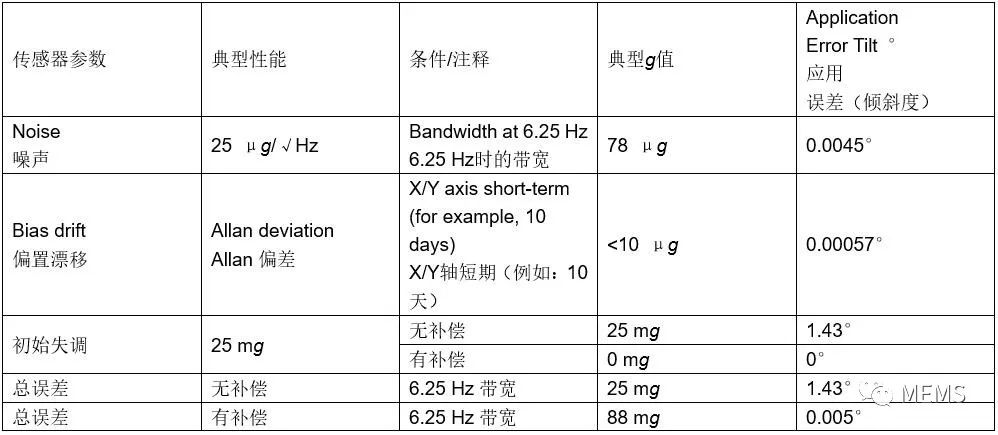Chris Murphy is an application engineer at the European Central Application Center, based in Dublin, Ireland. He joined ADI in 2012 to provide design support for motor control and industrial automation products. He holds a master's degree in electrical engineering research and a bachelor's degree in computer engineering.
problem:
My consumer accelerometer can theoretically measure tilts of less than 1°. Can such measurement accuracy still be achieved under temperature changes and vibration conditions?

answer:
The answer is probably no. It is always difficult to answer the question of clear tilt accuracy value, because many environmental factors need to be considered in the performance of MEMS sensor. Generally, it is difficult for consumer-grade accelerometers to detect tilts of less than 1° in a dynamic environment. To show this, we compare general consumer-grade accelerometers with a new generation of low-noise, low-drift, and low-power MEMS accelerometers. This comparison looks at the many error sources that exist in tilt applications and what errors can be compensated or eliminated.
You can observe 0 g offset accuracy, 0 g offset drift caused by soldering, 0 g offset drift caused by PCB shell alignment, 0 g offset temperature coefficient, sensitivity accuracy and temperature coefficient, non-linearity, and horizontal axis Sensitivity and other errors, and these errors can be reduced through the calibration process after assembly. Hysteresis, 0 g bias drift during service life, sensitivity drift during service life, 0 g drift caused by humidity, and PCB bending and torsion caused by temperature changes over time, etc. These error items cannot be solved by calibration or other methods. It requires a certain degree of in-situ maintenance to reduce. In this comparison, it is assumed that the horizontal axis sensitivity, non-linearity, and sensitivity are compensated, because compared to temperature coefficient offset drift and vibration correction, the effort required to minimize these errors is much less.
Table 1 lists the ideal performance specifications of the consumer-grade ADXL345 accelerometer and the estimated value of the corresponding tilt error. When trying to achieve the best tilt accuracy, some form of temperature stabilization or compensation must be used. In the following example, assume that the constant temperature is 25°C. The main error contributing factors that cannot be fully compensated are temperature drift, offset drift and noise. The bandwidth can be reduced to reduce noise, because tilt applications usually require a bandwidth below 1 kHz.
Table 1 Estimated value of ADXL345 error source

Table 2 ADXL355 error source estimates

Choosing a higher grade accelerometer is critical to achieving the required performance, especially when the application requires a tilt accuracy of less than 1°. Application accuracy depends on application conditions (large temperature fluctuations, vibration) and sensor selection (consumer vs. industrial or tactical). In this case, ADXL345 will need a lot of compensation and calibration work to achieve a tilt accuracy of less than 1°, increasing the workload and cost of the entire system. Depending on the magnitude of the vibration in the final environment and temperature range, it is impossible to achieve the above-mentioned accuracy. The temperature coefficient offset drift within the range of 25°C to 85°C is 1.375°, which has exceeded the requirement of less than 1° inclination accuracy.

The temperature coefficient offset drift of ADXL355 from 25°C to 85°C is:

As shown in Table 3, the vibration correction error (VRE) is the offset error introduced when the accelerometer is exposed to broadband vibration. When the accelerometer is exposed to a vibration environment, compared to the 0 g offset caused by temperature drift and noise, VRE will cause significant errors in tilt measurement. This is one of the main reasons why the data sheet is no longer used, because it is easy to obscure other main specifications.
Table 3 Error expressed in slope

¹The range of 1 g azimuth misalignment caused by 2.5 g rms vibration is ±2 g
In environments with higher amplitudes, an accelerometer with a higher g range must be used to minimize the offset caused by clipping. Table 4 lists the ADXL35x series accelerometers and their corresponding g range and bandwidth.
Table 4 Measuring range of ADXL354/ADXL355/ADXL356/ADXL357

Choosing the ADXL35x series accelerometers suitable for tilting applications will ensure high stability and repeatability, can withstand temperature fluctuations and broadband vibration, and require less compensation and calibration than low-cost accelerometers. This series of products are sealed and packaged, which can ensure that the repeatability and stability of the final product always meet the specifications after leaving the factory. ADI's new generation of accelerometers can provide repeatable tilt measurements in all environments, and they can achieve minimal tilt errors in harsh environments without extensive calibration.
Digital Printing Graphic Overlay
Digital Printing Graphic Overlay,Membrane Switches Graphic Overlays,Membrane Switch Panels ,Membrane Switch Button
CIXI MEMBRANE SWITCH FACTORY , https://www.cnjunma.com